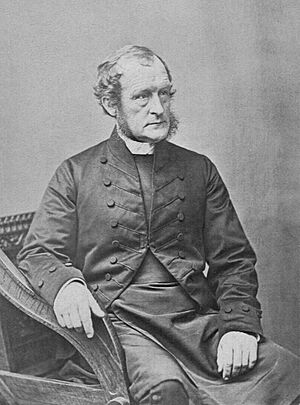Holy Trinity Church, New Plymouth facts for kids
Quick facts for kids Holy Trinity Church |
|
|---|---|
| Holy Trinity Church (Anglican) New Plymouth |
|

Holy Trinity Church, from the north
|
|
| 39°02′58″S 174°05′55″E / 39.049436°S 174.098652°E | |
| Location | 12 Henui Street, Fitzroy, New Plymouth |
| Country | New Zealand |
| Denomination | Anglican |
| History | |
| Former name(s) | Te Henui Church |
| Status | Church |
| Founded | 1842 |
| Founder(s) | Bishop George Selwyn |
| Architecture | |
| Functional status | Active |
| Architect(s) |
|
| Style | Gothic Revival |
| Years built | 1845–1872 |
| Completed | 1872 |
| Specifications | |
| Materials | Timber |
| Administration | |
| Parish | Holy Trinity Fitzroy |
Holy Trinity Church is an old and important Anglican church building. You can find it at 12 Henui Street in Fitzroy, New Plymouth, New Zealand.
This church is special because it's one of the oldest buildings from when Europeans first settled in New Zealand. It's listed as a Category 1 Historic Place by Heritage New Zealand. The church you see today replaced an earlier chapel built in the 1840s. That first chapel was started by Bishop George Selwyn. It was designed by Frederick Thatcher, an architect who came to New Plymouth in 1843.
The current church building has grown over time. The original part was changed in 1872. Then, it was made bigger in 1888 by James Sanderson. It was expanded again in 1903 by Francis Messenger. The church was also fixed up in 1927 and again in the 1960s.
Contents
The Church's Story
New Plymouth was chosen as a place for New Zealand's second European settlement. People started arriving there from 1841. These settlers wanted to have familiar things from home, like churches. They also wanted to share their faith with the Māori people. Most of the settlers belonged to the Church of England. So, a group called the Church Mission Society helped appoint a Bishop for New Zealand. This Bishop's job was to set up the Anglican Church across the country.
Bishop Selwyn's Arrival
In 1841, George Augustus Selwyn became the Bishop of New Zealand. He arrived in New Zealand in 1842 and began his important work.
After visiting New Plymouth in October 1842, Bishop Selwyn started planning to build churches. He appointed Reverend William Bolland to lead the church in New Plymouth. He also gave Reverend Bolland a sandstone house at Te Henui for his family to live in.
Bishop Selwyn also connected with Frederick Thatcher. Thatcher was an architect from London who arrived in New Plymouth in 1843. He was very important in designing many early churches in New Zealand. These churches often used a style called Gothic Revival.
Building the First Churches
With money from Bishop Selwyn, Reverend Bolland and architect Frederick Thatcher started building two new churches. One was St Mary’s Church in central New Plymouth. The other was Holy Trinity Church at Henui, which is now in Fitzroy.
Holy Trinity Church opened in 1845. Bishop Selwyn himself laid the first stone. It is known as the "oldest building built for Anglican church services in Taranaki." It is also one of New Zealand’s oldest churches still standing. The first building was made of wood and thatch. It was only meant to be a temporary church. However, the Taranaki Wars and other things delayed building a permanent church. This permanent church was finally built in 1872. It used wood boards and shingles instead of the older materials.
How the Church Grew
The church building you see today is much larger than the first one. It grew through several expansions. Changes in the 1870s and 1880s happened when many other early churches in New Zealand were also being replaced or made bigger. In 1888, the building was even divided in two to add new sections called transepts. After three more big building projects, the church became much larger. It changed from a small, simple building into a good-sized timber church.
The additions to Holy Trinity Church included features from the Gothic Revival style. These include the transepts, a rounded end section called an apse, tall narrow windows, and high, steep roofs.
Why Holy Trinity Church is Important
Holy Trinity Church is historically important because it shows how the Church of England started in New Zealand. It is connected to Bishop Selwyn, who was a very important person in New Zealand's history. It is also linked to local leaders like Reverend Bolland and Archdeacon Govett. These people helped shape the church in the mid-1800s. The original building also survived the Taranaki Wars, which makes it even more special.
The church is also important for its architecture. It was designed by Frederick Thatcher and later by other skilled local architects, James Sanderson and Francis John (Frank) Messenger.
The current building was officially recognized as a historic place on August 23, 2012. This was done by the New Zealand Historic Places Trust, which is now called Heritage New Zealand.
Image gallery






